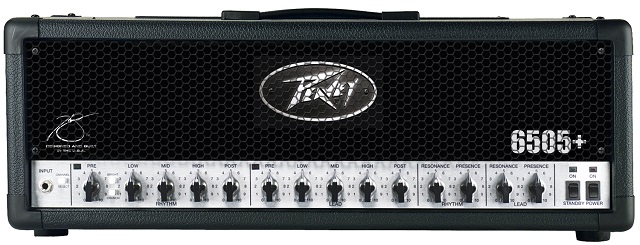yek
Contact Fractal for your Custom Title
* EDIT: Up-to-date information is available in Yek's Guide to the Fractal Audio Amplifier Models *

PVH 6160+: based on Peavey 6505+ (previously: EVH 5150-II)
Peavey is a large international manufacturer and supplier of musical equipment, since 1957. It owns Budda and Trace Elliot. Wikipedia
The EVH 5150-II was Eddie Van Halen’s 2nd signature amplifier, made in collaboration with Peavey as with the original EVH 5150. After the endorsement ended, this amplifier was continued as Peavey’s 6505+.
Why the name? 5150 is the police code for a crazy person on the loose.
EVH’s signature amps are well presented in Fractal Audio’s model collection:
More about the original EVH 5150 / Peavey 6506 here.
Wikipedia:
MXR has released a "5150" pedal.
The 6505+ head puts out 120 watts through 6L6 tubes, just like the original EVH 5150/Peavey 6505. It has a single input.
Cliff:
The amp has two channels: Rhythm (clean/crunch) and Lead. Our “RHY” model is based on the Rhythm channel with the Crunch switch depressed and Bright out. The “RHY B” model is based on the Rhythm channel with the Crunch and Bright switches depressed. “LD” is based on the Lead channel.
The amp’s controls are: Pre (model: Input Drive), Post (model: Master), Low, Mid, High, Resonance (model: Depth), Presence. And a Bright switch (6dB at 2kHz) and Crunch switch on the Rhythm channel. The Crunch switch changes the Rhythm channel from clean into moderate distortion.
Here’s the 6505+ manual, which also provides recommended settings.
Try the stock "4x12 6160 Mix" cab. Peavey uses V30 speakers in its 6505's 4x12 cabinet, so you can try V30 IRs too.

PVH 6160+: based on Peavey 6505+ (previously: EVH 5150-II)
Peavey is a large international manufacturer and supplier of musical equipment, since 1957. It owns Budda and Trace Elliot. Wikipedia
The EVH 5150-II was Eddie Van Halen’s 2nd signature amplifier, made in collaboration with Peavey as with the original EVH 5150. After the endorsement ended, this amplifier was continued as Peavey’s 6505+.
Why the name? 5150 is the police code for a crazy person on the loose.
EVH’s signature amps are well presented in Fractal Audio’s model collection:
- 5153: EVH 5150-III
- FAS 6160: modified version of the EVH 5150, less fizzy, with a bouncier feel
- PVH 6160 Block: original “block letter” EVH 5150 (now: Peavey 6505)
- PVH 6160+: Peavey 6505+ (previously: EVH 5150-II)
“These amplifiers (collectively the 5150 series) and speaker cabinets were the result of a collaboration with Eddie Van Halen. The 5150 has gained popularity with modern hard rock, hardcore punk and metal bands and guitarists due to its large amount of distortion. Jerry Cantrell of Alice in Chains uses this amplifier. While touring with Van Halen, Cantrell asked Eddie Van Halen, "if I could buy [one] off him at the end of the tour with them, and when I got home there were three full stacks and two guitars waiting for me."In 2004, Peavey and Eddie Van Halen parted ways, with Eddie taking the 5150 brand name with him. This resulted in the renaming of the amplifier as the 'Peavey 6505', with slightly updated styling but original circuitry. The 5150 II, which contains an extra preamp tube for more headroom and gain on the Rhythm channel, is the old equivalent to the new 6505+. In 2010, Peavey released a new amplifier for the 6505 line, the 6534+. It is much like the 6505+, but the 6534 has EL34 power tubes instead of the 6L6 power tubes on the standard 6505 amplifiers.”
More about the original EVH 5150 / Peavey 6506 here.
Wikipedia:
“A defining attribute largely responsible for the 5150 sound is the fixed bias. Commonly described analog a car engine and its respective idle, the 5150 bias was set to a lower value (lower engine "idle") which resulted in the Power Tubes running at a lower energy commonly known as "cold-biased." While the electrical theory behind this can easily be examined and theoreticized, the 5150 and its configuration resulted in a more controllable gain setting (ie. having a more forgiving sonic range than similarly "hot-biased" configurations. This engineering choice set the 5150 up to intrinsically sound its best with minimal augmentation. Since tube-amps are still uncontested in music amplification as far as tonal quality is concerned, (see hard-clipping) the optimal setting for tubes are when they are pushed to natural distortion (ie. Increases in "volume" or Bells(dB).) Thus, by allowing such a heavy amount of gain to be applied without sacrificing tonal definition, the amplifier could then be pushed due to the "colder" biasing requiring more current, versus a "hotter" setting from the beginning (volume knob or potentiometer knob "value of 1".)”
MXR has released a "5150" pedal.
The 6505+ head puts out 120 watts through 6L6 tubes, just like the original EVH 5150/Peavey 6505. It has a single input.
Cliff:
"Chris Quigley's 6505+ was the reference amp. It's my amp now. It's a very good sounding one."
The amp has two channels: Rhythm (clean/crunch) and Lead. Our “RHY” model is based on the Rhythm channel with the Crunch switch depressed and Bright out. The “RHY B” model is based on the Rhythm channel with the Crunch and Bright switches depressed. “LD” is based on the Lead channel.
The amp’s controls are: Pre (model: Input Drive), Post (model: Master), Low, Mid, High, Resonance (model: Depth), Presence. And a Bright switch (6dB at 2kHz) and Crunch switch on the Rhythm channel. The Crunch switch changes the Rhythm channel from clean into moderate distortion.
Here’s the 6505+ manual, which also provides recommended settings.
Personally I prefer the "+" model over the original 5150 (PVH 6160 Block). The "+" models feel more elastic and smoother.
Try the stock "4x12 6160 Mix" cab. Peavey uses V30 speakers in its 6505's 4x12 cabinet, so you can try V30 IRs too.
Last edited:
